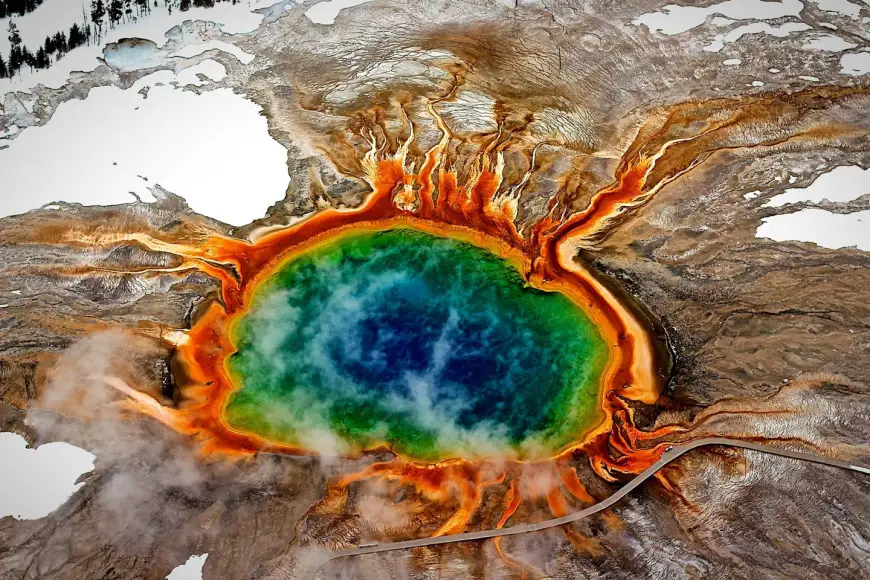
New seismic analyses of the magma under the Yellowstone supervolcano are sharpening the picture of what lies beneath and keeps features such as the Grand Prismatic Hot Spring (shown) simmering.
Marie-Louise Mandl/EyeEm/Getty Images
- More than 2 years ago
More liquid magma lurks beneath the Yellowstone supervolcano than scientists once thought. But don’t panic: That amount of magma, researchers say, is still nowhere near enough to portend an eruption any time soon.
That reassurance comes courtesy of new state-of-the-art seismic images that give the sharpest picture yet of what lies beneath Yellowstone.
“It’s like getting a better lens for your camera. Things are coming into more focus,” says Michael Poland, a geophysicist who was not involved in the research. “We’re even less worried about an eruption now — and I wasn’t worried before,” adds Poland, who is the scientist-in-charge at the U.S. Geological Survey’s Yellowstone Volcano Observatory in Vancouver, Wash.
The volcano beneath Yellowstone National Park has garnered interest — and worry — because it has had some of the most explosive, dramatic eruptions in the geologic record, he says. In the last 2.1 million years alone, Yellowstone has had three catastrophic eruptions, generating continent-wide ashfalls and disrupting the global climate.
The most recent of those catastrophic outbursts was about 631,000 years ago, forming a crater about 70 kilometers across (SN: 1/2/18).
Yellowstone’s subterranean magma chambers mostly contain hardened, cooled crystals that are mixed in with some amount of molten material. How much magma there is relative to crystals can determine how ready a volcano is to erupt. The average amount of liquid magma in the volcano’s underbelly is between 16 and 20 percent, Ross Maguire, a geophysicist at the University of Illinois Urbana-Champaign, and colleagues report in the Dec. 2 Science.
The “critical melt fraction” at which the volcano might be prepared to erupt is more like between 35 and 50 percent, the team notes.
Previously, researchers had estimated Yellowstone’s melt fraction as between 5 and 15 percent. The new estimates don’t represent an actual change — they’re based on a reanalysis of existing seismic data that required far more computational power than was possible in the past.
“We’re not absolutely pushing the limit in terms of what we can do,” Maguire says, “but we’re getting kind of close.”
Peering beneath Yellowstone
To “see” beneath the surface, scientists use information gleaned from the speeds of different types of seismic waves as they travel through the ground. Seismic waves known as “S waves” are particularly useful when looking for melt because these waves slow down considerably when they encounter any liquid, such as water or molten magma.
Researchers use the time it takes for an S wave to travel from a transmitting source to a receiver, compared with the time it takes for other types of seismic waves that don’t slow down in liquids, to estimate how much melted magma there is.
Before the rise of supercomputers, scientists would imagine the seismic waves as moving along a simple line from point A to point B. Then they would convert the travel time for the wave to a velocity and from there estimate some amount of liquid present.
But waves don’t really move in a line; they radiate outward. They diffract. When encountering a subsurface feature that could slow them down, they might bend around it rather than barrel through it. Those additional wave movements add a lot of fine detail to the picture — but they also require a lot of computational power.
Today, such calculations are possible. So Maguire and colleagues used this more modern way of looking at seismic waves — called full waveform tomography — to reanalyze existing seismic data from Yellowstone.
Peering between three and eight kilometers underground, the team recorded S waves as slow as about 2.1 kilometers per second, occurring near the center of Yellowstone’s caldera. That’s appreciably slower than previous estimates of 2.7 km/s, Maguire says, pointing to more melt.
It’s not certain how the melted part of the magma is distributed. But the most likely scenario is that most of the liquid is isolated, tiny amounts of melt locked away in the spaces between the hardened crystals. Still, the team notes, it can’t rule out the possibility that there are larger pockets of molten magma scattered about.
Yellowstone set to simmer?
One interesting implication, Maguire says, is that “Yellowstone may spend large portions of its life cycle with higher melt fractions than thought.” That contradicts the classic view that the volcano’s magma chambers are usually filled with cooled crystals, punctuated by rapid injections of magma before an eruption. Instead, Yellowstone may just be in a long-standing simmering state.
But a bit of simmering is a far cry from about to erupt, Poland says, and these new findings “help to drive home the point that this system is mostly solid.” That’s probably why it hasn’t erupted even small amounts of magma in nearly 70,000 years.
That doesn’t mean Yellowstone is quiescent: It’s still a hot, active volcanic system with hazards, Poland notes. For example, in recent decades there have been deadly steam explosions and landslide-triggering earthquakes (SN: 1/11/21).
Those more likely hazards don’t get as much attention as fears of a catastrophic eruption. “It’s kind of a bogeyman for people and a clickbait topic, and it’s sad,” Poland says. “It’s an interesting place that has so much to offer, and people are focused on the thing that won’t happen in our lifetime.”






